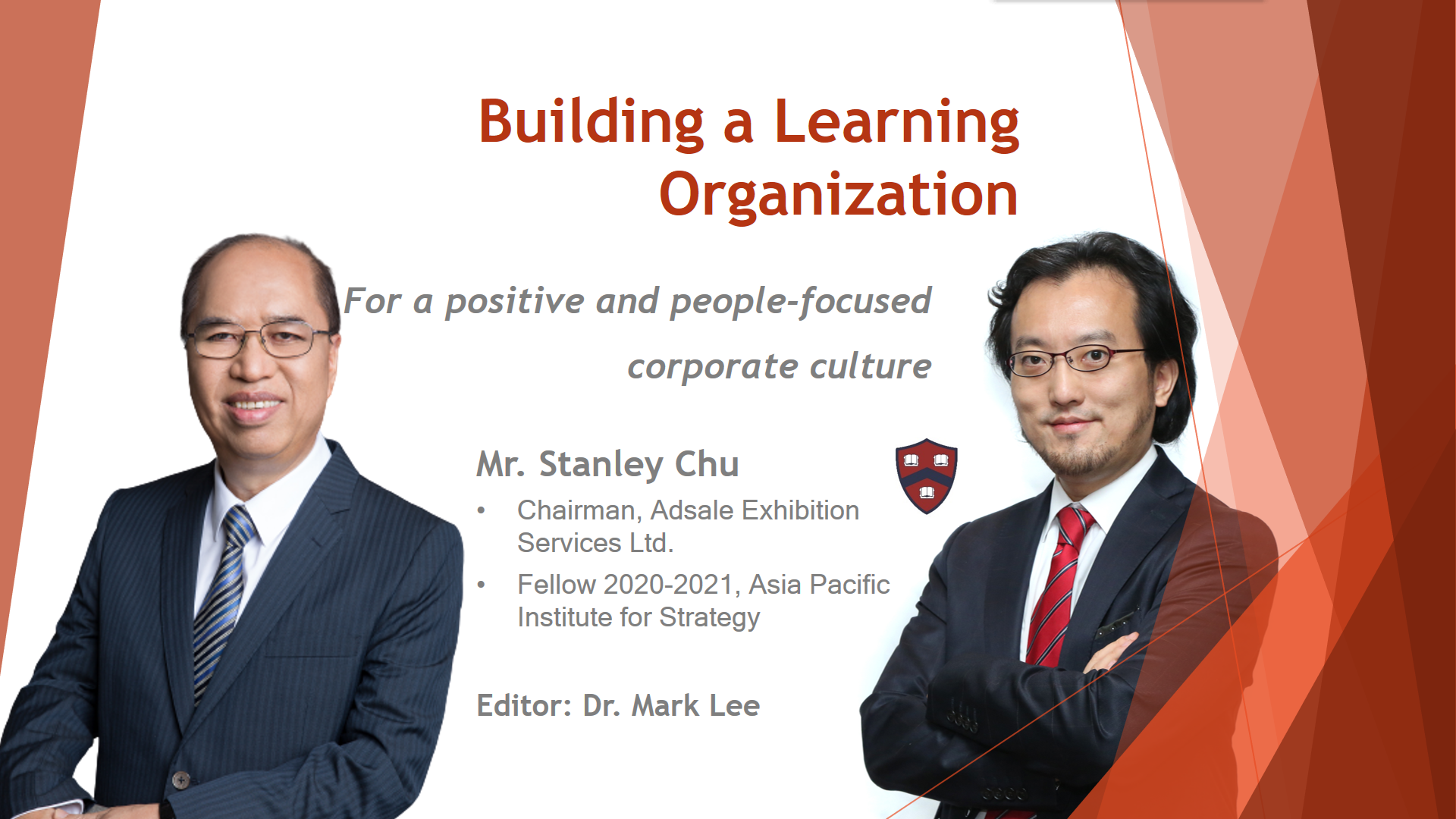
[Development Strategy] Building a Learning Organization:For a positive and people-focused corporate culture
Stanley Chu
- Chairman, Adsale Exhibition Services Ltd.
- Fellow 2020-2021, Asia Pacific Institute for Strategy ( 亞研所院士 )
Forty-two years ago, I had to quit my job as a secondary school mathematics teacher due to persisted sore throat. The future was misty for me at that time. With two young people of my age, we started a small company in Wanchai offering advertising promotion services. There were many competitors offering similar services and pricing and there was one question that always came into our mind. Which one is our most fearful competitor? After long debate and arguments, we concluded it would be a company that keeps on learning and manage to keep in pace with changes in time. Our determination then became “Building our own company a Learning Organization.”
Throughout the years, we realized to transform into a learning organization, there are a few building blocks, as described in an article “Is Yours a Learning Organization?” by David A. Garvin , Amy C. Edmondson and Francesca Gino.
Firstly, we need to provide a supportive learning environment.
This environment has to be conducive to staff to learn from each other, to learn from customers, suppliers and even competitors. Most important of all, to learn the major changes in the market place. In our starting time, it was China’s open door policy and the opportunities that arose.
Nowadays, our company has become a major exhibition organizer with about 350 staff. Our flagship event is the largest in the world in terms of size. The company has many project teams and supporting departments. We encourage colleagues to learn from each other through project meetings held quarterly. The meetings involve front line and supporting department and from the Chairman to junior staff. In these meetings, strategic directions as well as practical work are discussed. Frontline and supporting department representatives would take turns to report on their progress.
We believe through the meetings, we achieve below points:
1. Make information transparent and not be monopolised by the senior management;
2. Executive of all levels has the opportunity to participate in the strategic direction formation of the projects for which he or she is involved;
3. Senior management is able to encourage different ideas to be expressed and be appreciated. Rarely are any ideas or work discredited at the meetings;
4. Mid-level executives’ reports become an opportunity to speak up and taking ownership of work.
Secondly, we need to provide concrete learning processes and practices.
We started the Annual Conference program since 2005. Each year a specific topic would be chosen 6 months in advance. Past topics include, Change Management, Blue Ocean Strategy, Business Model Generation, Digital Transformation, Design Thinking, Big Data and etc. The topics picked are highly relevant to market trends. The objective is to learn basic theories, master useful tools and techniques and apply the knowledge to concrete work issues.
The program consists of 3 parts.
1. Pre-reading and survey;
2. Two-day training with professional trainer;
3. Sharing sessions conducted 9 months after training for teams to share their application of theories in their work.
We are amazed by the commitment of colleagues and the quality of their learning at the sharing sessions. After a few years, we recognized other than the theories, we have established a corporate culture that is positive, respectful to teamwork, courageous, takes ownership and continuously wants to learn and share.
Thirdly, we should have leadership that reinforces learning.
As Chairman of the Company, I put annual conference and quarterly project meetings in a high priority. In turn, our senior management team also considers such with high importance. It has become our DNA that we want to learn and improve. In recent years, learning has provided us with confidence to face fierce competition and fast-changing environment. The positive reinforcement has allowed us to further our pursuit. There is never an end to learning; we rely on our people to grow our organization in this complex and changing times.
The world is changing so fast these days. With Covid-19 and US/China conflict, we are seeing a turbulence business environment that would need us to take quick actions and constant monitoring our plans for the future. This can only be done if our company is a learning organization. I hope our little experience can be of reference to other organizations in Hong Kong.
Related Articles:
[Green Strategy] The Earth Caught a Cold:Challenges of Running Green Businesses[Change Management] What can we do to face the challenges of the New Normal?
[CFO Strategy]How to prepare for a new round of pandemic as soon as possible?
[Crisis Management ] Deal Terms Renegotiation: Investment Agreement is a Prenup?
[Stanford University Graduates Partnership] How to build a hundred-billion-dollar enterprise
[Crisis Management for the Pandemic]Portfolio Management and Best Practice: The Rule of 30%
[Asset Management for the Pandemic] Real Estate Investment Philosophy in Disrupted Times
[Change Mgt for the Pandemic] 6 Tactics and Pitfalls to Win People's Hearts to Change Effectively
[Crisis Management for the Pandemic]Trend and Crisis Management:The Worst of Time, The Best of Time
《Tai Hing 3.0》Foreword by Dr. Mark Lee:Upgraded Strategy, Advanced Enterprise
[CEO Insights]Crystal Interview:Management Philosophy for an Enterprise from Zero to Billions
[CEO Coaching]Octopus Interview: Innovative Thinking Strategy
[CEO Coaching]BEA Interview: Development Opportunities for Hong Kong Banking Industry
[CEO Coaching]Pfizer Hong Kong Exclusive Interview:What makes a successful enterprise?
[CEO Coaching]Ericsson (HK) Limited Interview:Would Hong Kong lose its competitive edge in 5G era?
Australia: +61 3 9015 4991
Singapore: +65 6850 5067
Hong Kong: +852 3970 1828
Email: cs@apifs.net
Asia Pacific Institute for Strategy (C) 2025
